Motion breakdowns
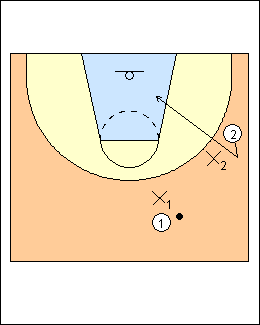 | 1 See Offence - 4-out 1-in motion and Huggins open post for examples of motion options and progressions. 2 on 2 a) Perimeter Attacking options - basket cut (give and go) - corner cut - backcut (shown) - dribble-at - dribble-loop - ballscreen - handback - space on dribble penetration. Stuart Manwaring FIBA Oceania The concept of offence is to take the ball to open space, away from defence and toward the basket. Leaving an area creates space for another player to come into. Play on the outside, score on the inside - create player and ball movement on the outside, leaving the lane open to move into. Teach motion offence without then with screening. Start with 2 on 2 quarter court (on one side), no dribble and no scoring, pass then move away from your defender and the ball into open space, without the ball focus mainly on your defender, use peripheral vision to see him and the ball. Then add scoring (still no dribble) but only from within the lane and below the jump-ball circle to encourage layups. |
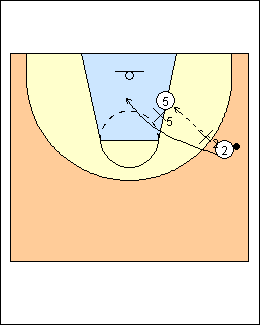 | 2 b) Perimeter and post - ballscreen - space on dribble penetration - low-post entry pass - Laker cut (shown), relocate - high-post entry - handback See Pitt 2 on 2 ballscreen, Spurs two-game. |
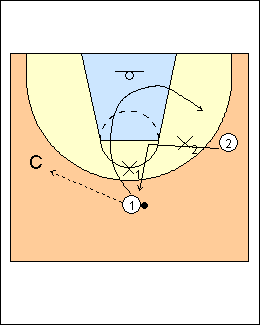 | 3 2 on 2 with passer Start with a pass to or from coach, who can also be a "release man", pass back to him if there is no play. a) Perimeter Other attacking options - pass and screen away - fill cut as needed - flarescreen John Tauer - pass to coach, screen away, then it's live 2 on 2. See Allison McNeill screening, Fast-break ballscreens. |
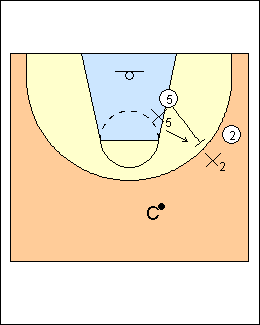 | 4 b) Perimeter and post Other options - backscreen (shown) - downscreen See 2 on 2 - Pitt backscreen, Halfcourt with passer, Off the skip, Mike MacKay ballscreens, Horns sidescreen. c) Two low posts - cross-screen See 2 on 2 posts, and Post play - 5star 2 on 2. |
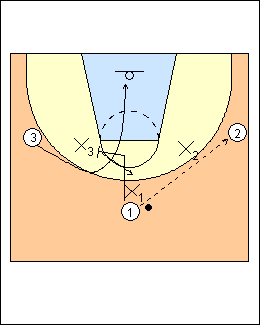 | 5 3 on 3 a) Perimeter Same options as 2 on 2 with passer. See 3 on 3 - Paul Hewitt, Bill Self, also Huggins on the side. John Tauer - pass, cut and fill, or screen away (layups only to encourage screening), see Offence - 5-out youth motion. Stuart Manwaring - 3 on 3 halfcourt (guard, two wings) - No dribble, no scoring, initially players without the ball move to get open within their areas, then allow the wings to exchange, as one wing cuts to the basket he creates space for his teammate to run into. When a player passes he should cut to the basket. - No dribble, add scoring within the lane and below the circle, and ensure only open shots (pass if contested), players are learning to play on the outside and try to score on the inside. - With dribble and scoring, use the dribble to take the ball to an open space and toward the basket where possible - penetrate toward the basket or improve a passing angle (including a retreat dribble). Then add a dribble entry and shallow cut (or backcut) when the wing is denied. |
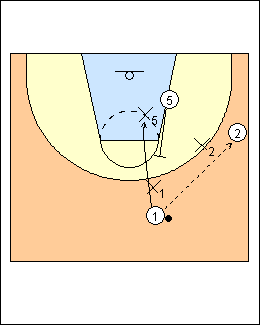 | 6 b) Perimeter and post Other options - high-post rub (shown) - zipper cut (dribble loop) - low-post entry - screen away, post split - high-post entry - wing backcut. See 3 on 3 - Back-down-UCLA screens, UCLA-ballscreen, Horns on the side, Mike Procopio, also Horns high posts (two high posts), and Post play - 5star 3 on 3. Stuart Manwaring - 3 on 3 quarter court, use the triangle (guard, wing, low post) - No dribble, with scoring. The player in the low post leaves his area first e.g., up the lane or out to the sideline to create space for the wing to cut into. Then allow passes into the low post, start with back-to-the-basket post moves then front-to-the-basket moves. Outside shooting can be added from a pass out of the low post (inside/out game). Add screening, breakdown drills are the same, the major difference is that instead of two players exchanging positions, one sets a screen for the other. The cutter's first movement should be away from the screener. The cutter can curl cut, flare, or backcut, following the concept of offence - move to an open space away from his defender, i.e. on the opposite side of the screen. The screener opens and goes to the ball if the cutter goes to the basket, or opens and goes to the basket if the cutter goes to the ball. The screener always opens by pivoting to see the cutter first then the ball, the cutter's defender will be on his back, which is important if the defence switches to defend the cutter, then the screener is usually open. Coaches should have scorers set screens, or re-screening will allow a scorer who has cut off a screen to get open from a screener position against a switching defence. Players should not be allowed to set on-ball screens until they have mastered off-ball screens, then follow the same rules for the cutter and screener. - No dribble, no scoring, but with screening (off the ball - back, down, flare). Initially cutters must use the screens, later they can reject the screen if their defender cheats. Read the defender and move to space away from him. - No dribble, with screening, add scoring within the lane and below the circle (encouraging backscreens), ensure only open (uncontested) shots. - Add dribble, with scoring and screening. Use post moves and the inside/out game, scoring is now from anywhere in shooting range (stress good shot selection). A general rule used by many coaches in motion offence is that a perimeter player without the ball should always screen for a player below him on the same side of the court, e.g., the guard downscreens for the wing on a pass into the low post. Use the dribble only to penetrate the basket or improve a passing angle. - Add a dribble entry and shallow cut if the wing-entry pass is denied, the wing can simply cut above the low-post area, or cut below the low post and use a screen (although there can be a problem of too many players in one area). - Just let the players play in triangles, encourage all players to be a threat in the low-post position. |
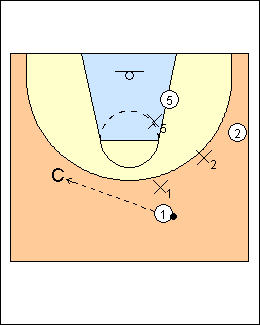 | 7 3 on 3 with passer Other options - flarescreen with 5 - up-and-down screen with 5 See 3 on 3 - Paul Hewitt, Allison McNeill screening, Motion ballscreens, also Downscreen cross-screen (two low posts), Flexscreens (two passers). Stuart Manwaring - 4 on 3 quarter court, no dribble, with scoring, three players in a triangle plus a weakside passer, who gets a pass only when the ballhandler sees that one of his teammates is going to be open from the other side of the court. Progression - add screening. |
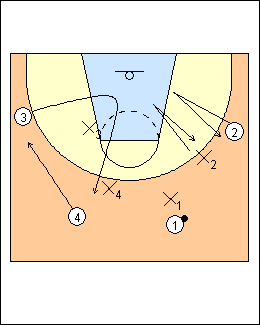 | 8 4 on 4 Stuart Manwaring - Halfcourt with two guards and two wings, playing up and down on each side, initially the two weakside players exchange with each other, the guard can cut to the basket allowing the wing to flash up, or the wing can make a baseline cut (like a shallow cut) allowing the guard to flare wide (shown). The ballside player without the ball must get open in his area. Always look to reverse the ball against good defence. - Add scoring with one dribble to a layup (no other shot allowed). - Add playing across the court, a player without the ball can work with a teammate on the other side of the court, if a ballside player crosses the court he sets up a clear-out for the ballhandler. Allow a dribble for penetration and to create a passing angle. - Add screening, play up and down, use downscreens on each side of the court. - Add playing across the court with screening, a player without the ball can communicate with a wing or guard on the other side and cross the court to set a backscreen for him. |
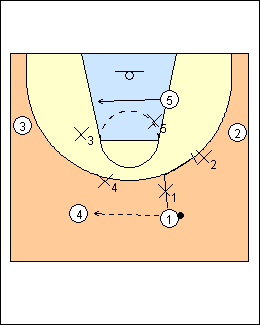 | 9 5 on 5 Stuart Manwaring - Halfcourt with two guards, two wings, a low post, dribbling, scoring inside. If a teammate is not entering the lane on ball reversal, the low post should change sides to form a triangle on the other side (have the low post turn and face the lane on ball reversal to read the defence and see if the lane is open). - Add screening. In breakdown drills, instead of a standing start, have the point guard dribble into the frontcourt with his teammates already moving to get open. Rules for every offence - maintain good spacing - maintain court balance - movement of ball and players - use patience and timing - use good shot selection. Criteria for offences in beating the defence - create a side of the court (get the ball out of the middle) - take the ball below the foul line (flatten the defence) - take the ball inside (make the defence collapse) - reverse the ball. |
This page was made with Basketball playbook from Jes-Soft